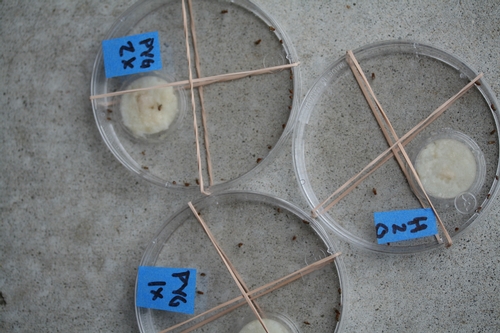
- Posted By: Mark Bolda
- Written by: Mark Bolda
It was perhaps only inevitable that some laboratory work with a private industry researcher has discovered a high level of tolerance, maybe even resistance, to the popular organically registered pesticide Pyganic (active ingredient pyrethrin) in spotted wing drosophila. Using the system of Petri plates photographed below, groups numbering from 15 to 22 flies were subjected to the label rate (18 fl oz) and twice the label rate (36 fl oz) of Pyganic 5.0 II with the result that spraying them had very little effect and most survived. This has been repeated several times, so we know it is not by chance that this is happening.
The population subjected to this laboratory testing has been exposed in the source field to many applications of Pyganic- there's not a lot of choices in organic culture- over the past two years, so it comes as no surprise. Admittedly it seems rather fast. Do note also that pyrethrin is a weaker version of the synthetic pyrethroids such as zeta cyper-methrin (Mustang Max) and bifenthrin (Brigrade) so we do have a flashing yellow with these materials also.
It is so important that we continue to rotate the pesticides we are using against spotted wing drosophila.



So you know, we are pursuing non chemical solutions to SWD really hard this autumn, and there is some hope on some of it. We will discuss a lot of this at our entomology meeting to be held here at the office 1432 Freedom Blvd, Watsonville on Sept 13. If you are interested in SWD in caneberries, I don't think you'd want to miss this event. The agenda is posted on our county ce website.
Cheers,
Pontus
If you email me, I'll send you the contact info of my colleague.